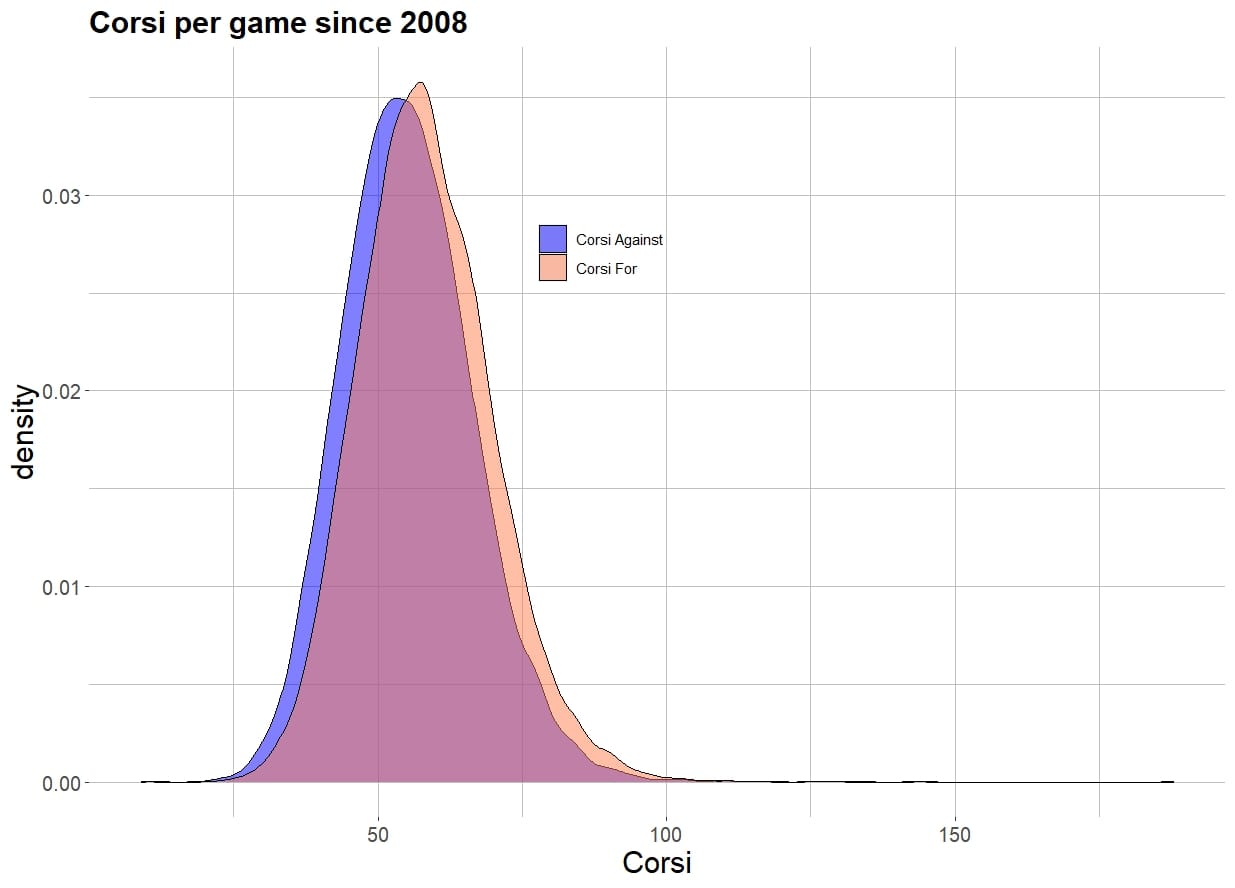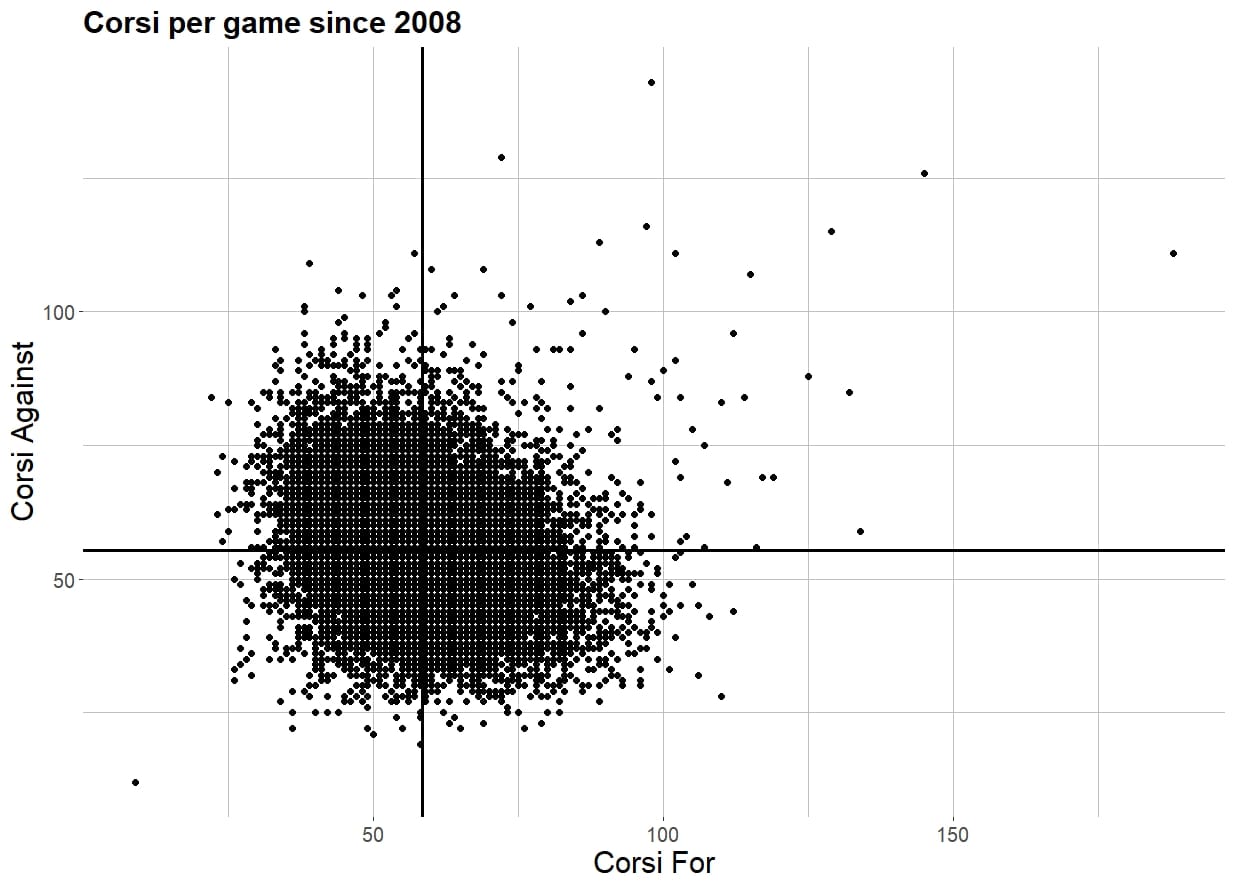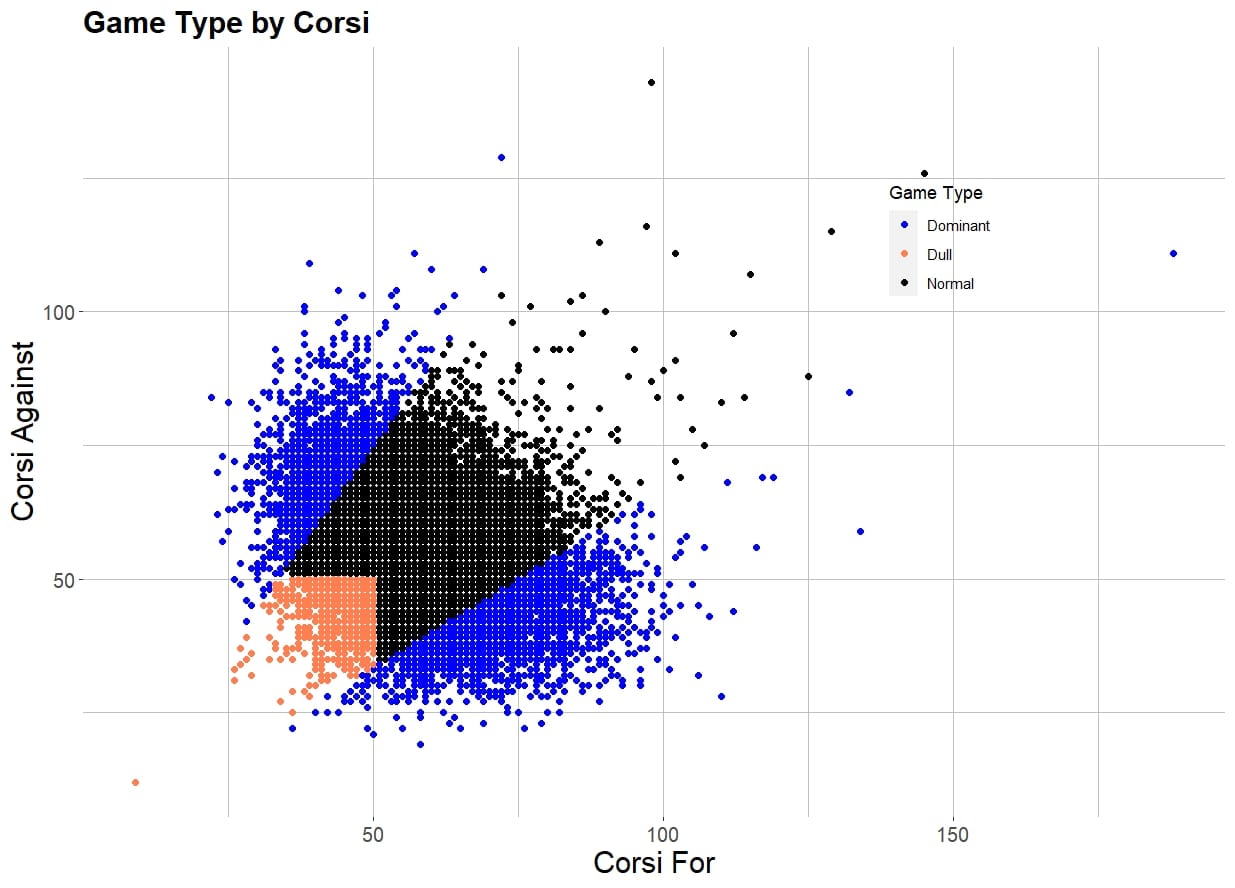During Friday's game against the Red Wings, there was a lot of talk about low-event hockey. The Leafs had intended, per Max Pacioretty, to keep the Wings to a low event game. In doing that they joined them in not shooting the puck much. To be honest, I found long stretches of the second half of the game very dull. But it got me thinking: What does low event really mean. Is it how a game feels, or is it about shots. Do both teams need to be shooting very little, and anyway what is "very little"?
How often are NHL games low event?
Before I started trying to answer that question, I had to define all these terms and make some arbitrary choices. All I knew was that league average Shots on Goal are about 30 per team per game, and that number has very slightly risen over the last few years.
Shots on Goal are a bad measure of overall activity, though, so the first choice I made was to use Corsi or all shots. This is the average Corsi over the seasons it has been measured per game per team:
| Season | Mean Corsi |
|---|---|
| 2008 | 54.95 |
| 2009 | 55.85 |
| 2010 | 56.64 |
| 2011 | 55.42 |
| 2012 | 55.41 |
| 2013 | 56.08 |
| 2014 | 56.18 |
| 2015 | 55.81 |
| 2016 | 56.55 |
| 2017 | 59.02 |
| 2018 | 57.70 |
| 2019 | 57.04 |
| 2020 | 54.52 |
| 2021 | 57.04 |
| 2022 | 58.49 |
| 2023 | 60.95 |
| 2024 | 60.35 |
A gentle rise, with the ever-present blip in 2020-2021.
Next, we need the distribution of Corsi per game, so see how much it varies.

This is all games taken from the home team's perspective which is 20,385 games. The home team shoots a very small amount more – which is not surprising, but overall, the vast majority of games are played right around the mean which is 57 per team per game overall. This alone says there aren't very many games with meaningfully low shooting.
But we can't just call any game below the mean low event. And what about games where only one team is low event because the other team is dominating the shotshare?
This is all of the games:

And as expected, it's a lot easier to get unusually large numbers than unusually small. There's just more room on the upside. It's also obvious the games where both teams are below the average is the smallest segment of this blob of results.
I thought it over, and these were my arbitrary decisions. A game where the Corsi % is at least 60 is a dominant game. A game where both teams are below 50 in Corsi is a dull game. I picked 50 as it's a nice round number near the 25th percentile on both Corsi For and Against.

In reality, our feelings about a game are fuzzier than those hard demarcations, but this does show that the vast majority of games 14,781 to be exact, are close in shots, and at least at 50 per team. The Dull segment is a mere 1,174 and the dominant games are 4,430. Which raises a side point – don't expect the Leafs to play in a dominant fashion all the time. No one does.
That Red Wings game? It just barely squeaks into the black courtesy of the Leafs who were 56-50 in all-situations Corsi. So, yeah, that's in that fuzzy range where it feels low event. Which brings me nicely to the Saturday contest with the Canadiens. No contest, really.
In all-situations, the Leafs barely bothered to have the puck in the third period with a big lead, and the final all-situations Corsi count was 59-44 for Montréal, so not quite in the blue domination range, and just barely into the black, but because the Leafs were in charge until the game was in the bag, it felt different to me. A Canadiens fan might have a different point of view.
Feelings can be swayed by the score, but also how exciting individual events are. So to be really dull in feel, a game may merely need to be lacking in high-danger shots on both sides.
The Detroit game was 3-2 for Detroit, and the Montréal game was 2-1 for the Leafs. And that could well be why the games seemed a little duller than the Corsi rate indicated
Note: Moneypuck uses a different definition for High Danger than many people are used to. It's >= 20% Expected Goals probability. Because Expected Goals weighting is based mostly on location, it's broadly similar to Natural Stat Trick's method, but they come up with larger numbers of shots in each game. Moneypuck's method is stingier.
Moneypuck's High Danger Shots per Game per Team
| Season | Mean High Danger Shots |
|---|---|
| 2008 | 2.46 |
| 2009 | 2.53 |
| 2010 | 2.45 |
| 2011 | 2.44 |
| 2012 | 2.34 |
| 2013 | 2.46 |
| 2014 | 2.48 |
| 2015 | 2.55 |
| 2016 | 2.59 |
| 2017 | 2.61 |
| 2018 | 2.73 |
| 2019 | 2.81 |
| 2020 | 2.62 |
| 2021 | 2.99 |
| 2022 | 3.40 |
| 2023 | 3.56 |
| 2024 | 3.60 |
You have to be better these days to not be boring. This is something already examined in my look at how much teams score over the years. Fan expectations have been raised, and if the Leafs seem to be a little dull off the power play in the last few games, it's because they have been. Overall this season they are almost dead on that mean Corsi per game number above in all-situations Corsi For, with a shade less in the against column. The ratio is right - barely - but the pace is low.
If you want to console yourself with the idea that the power play has been holding back that overall game pace, well, the five-on-five play is always the real driver of the bus, and it's going the speed limit and not a bit more. A more plausible view is that the early period involved a lot of new systems work and the dullness of the team will dissipate in time as everyone stops thinking too much.
A lot of people believe offence and defence are a see-saw and to have good defence, you have to have less offence. It's a morality tale about not selfishly trying to score when you should be conforming to the low-risk defensive system. Is it true? That's a question for another day, but I don't buy in.




Comment Markdown
Inline Styles
Bold: **Text**
Italics: *Text*
Both: ***Text***
Strikethrough: ~~Text~~
Code: `Text` used as sarcasm font at PPP
Spoiler: !!Text!!